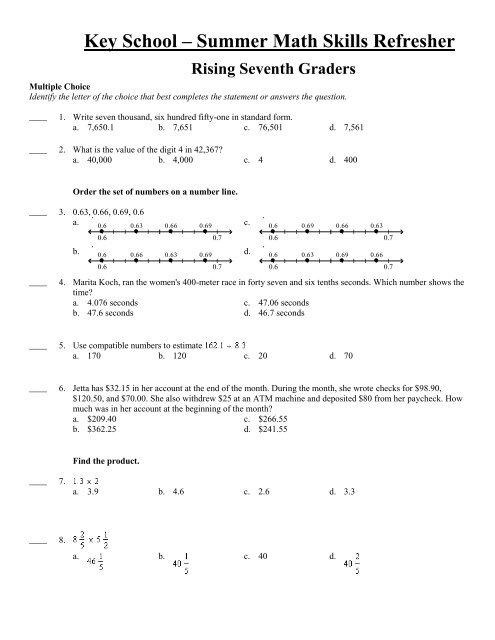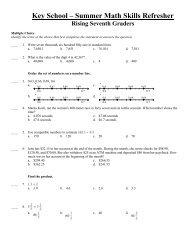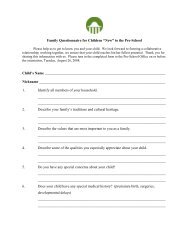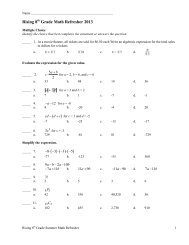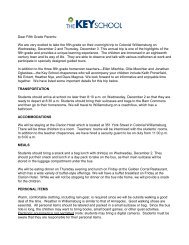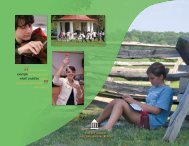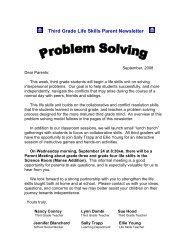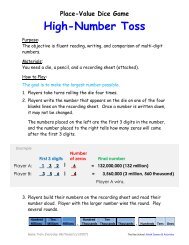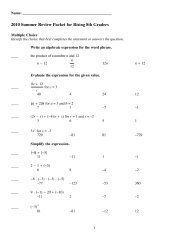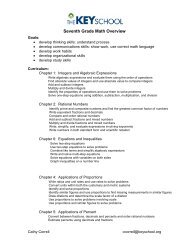Math summer work: entering 7th grade - Key School
Math summer work: entering 7th grade - Key School
Math summer work: entering 7th grade - Key School
You also want an ePaper? Increase the reach of your titles
YUMPU automatically turns print PDFs into web optimized ePapers that Google loves.
<strong>Key</strong> <strong>School</strong> – Summer <strong>Math</strong> Skills Refresher<br />
Rising Seventh Graders<br />
Multiple Choice<br />
Identify the letter of the choice that best completes the statement or answers the question.<br />
____<br />
1. Write seven thousand, six hundred fifty-one in standard form.<br />
a. 7,650.1 b. 7,651 c. 76,501 d. 7,561<br />
____ 2. What is the value of the digit 4 in 42,367?<br />
a. 40,000 b. 4,000 c. 4 d. 400<br />
Order the set of numbers on a number line.<br />
____ 3. 0.63, 0.66, 0.69, 0.6<br />
a.<br />
____<br />
b.<br />
0.6 0.63 0.66 0.69<br />
c.<br />
0.6 0.7<br />
0.6 0.66 0.63 0.69<br />
d.<br />
0.6 0.7<br />
0.6 0.69 0.66 0.63<br />
0.6 0.7<br />
0.6 0.63 0.69 0.66<br />
0.6 0.7<br />
4. Marita Koch, ran the women's 400-meter race in forty seven and six tenths seconds. Which number shows the<br />
time?<br />
a. 4.076 seconds c. 47.06 seconds<br />
b. 47.6 seconds d. 46.7 seconds<br />
____<br />
5. Use compatible numbers to estimate<br />
a. 170 b. 120 c. 20 d. 70<br />
____ 6. Jetta has $32.15 in her account at the end of the month. During the month, she wrote checks for $98.90,<br />
$120.50, and $70.00. She also withdrew $25 at an ATM machine and deposited $80 from her paycheck. How<br />
much was in her account at the beginning of the month?<br />
a. $209.40 c. $266.55<br />
b. $362.25 d. $241.55<br />
Find the product.<br />
____ 7.<br />
a. 3.9 b. 4.6 c. 2.6 d. 3.3<br />
____ 8.<br />
a. b. c. 40 d.
____<br />
9. Andre has $9. He wants to buy slices of pizza for himself, his aunt, father, and cousin. Everyone will get the<br />
same size slice. What is the biggest size Andre can afford?<br />
Slices of Pizza<br />
(tax included)<br />
Size<br />
Price<br />
Small $1.49<br />
Medium $2.49<br />
Large $3.49<br />
Extra Large $3.99<br />
a. extra large b. medium c. small d. large<br />
Evaluate the expression.<br />
____ 10.<br />
a. 51 b. 76 c. 41 d. 16<br />
____ 11. A mail-order supplier of small electrical parts charges a shipping fee of $7, plus $2 for each pushbutton light<br />
switch ordered. If x is the number of pushbutton switches ordered, then the expression for the total cost of an<br />
order is Which table shows the total cost for the given number of switches ordered?<br />
a. c.<br />
b. d.<br />
Write an algebraic expression for the word phrase.<br />
____ 12. 9 times the product of c and d<br />
a. 9(c + d) b. 9cd c. d. 9(c – d)<br />
2010 Summer Review 2 Rising 7 th Grade
Solve the equation.<br />
____ 13.<br />
____ 14.<br />
a. 50 b. 150 c. 200 d. 100<br />
a. 6.3 b. 6 c. 7.3 d. 12<br />
____ 15. Write the expression<br />
a.<br />
b.<br />
c.<br />
d.<br />
using an exponent. Name the base and the exponent.<br />
____ 16. Use the Distributive Property to simplify the expression .<br />
a. 7.9 b. 9.5 c. 6.9 d. 19<br />
Write the next two terms in the pattern.<br />
____ 17. 6,250, 1,250, 250, 50, . . .<br />
a. 60, 3 b. 15, 3 c. 10, 2 d. 60, 2<br />
____ 18. Test 31,186 for divisibility by 2, 5, or 10.<br />
a. It is divisible by 5, but not by 2 or 10. c. It is divisible by 2, but not by 5 or 10.<br />
b. It is divisible by 2, 5, and 10. d. It is divisible by 5 and 10 but not by 2.<br />
____ 19. Which digit(s) makes 3,71 divisible by 3?<br />
a. 3 only b. 7 only c. 1 only d. 1, 4, and 7<br />
____ 20. Use prime factorization to find the GCF of 22 and 60.<br />
a. 4 b. 1 c. 2 d. 3<br />
List all the factors of the number.<br />
____ 21. 40<br />
a. 1, 2, 3, 5, 10, 15, 50 c. 1, 2, 4, 5, 8, 10, 20, 40<br />
b. 1, 2, 5, 10, 25, 50 d. 2, 3, 4, 10, 20, 30, 40<br />
____ 22. Which fractions are equivalent to ?<br />
a. b. c. d.<br />
2010 Summer Review 3 Rising 7 th Grade
Write the improper fraction as a mixed number in simplest form.<br />
____ 23.<br />
a.<br />
b.<br />
c. 13 d.<br />
14 2 3<br />
13 2 3<br />
12 2 3<br />
____ 24. List multiples or use prime factorization to find the LCM of 27 and 45.<br />
a. 45 b. 675 c. 1,215 d. 135<br />
Compare the pair of numbers. Use .<br />
____ 25.<br />
a. b. c.<br />
____ 26.<br />
a. b. c.<br />
Order the numbers from least to greatest.<br />
____ 27.<br />
a. c.<br />
b. d.<br />
Find the sum.<br />
____ 28.<br />
a.<br />
b.<br />
c. 6<br />
d.<br />
1 9 14<br />
2 1 7<br />
7<br />
1 1 14<br />
____ 29.<br />
a. 4<br />
b. 1<br />
c. 1<br />
d. 5<br />
5<br />
24<br />
5<br />
24<br />
2010 Summer Review 4 Rising 7 th Grade
____ 30.<br />
a. b. c. d.<br />
____ 31. 15 + 38<br />
a. –23 b. –53 c. 53 d. 23<br />
____ 32. –30 + (–9)<br />
a. –21 b. 21 c. 39 d. –39<br />
Find the difference.<br />
____ 33.<br />
a. b. c. d.<br />
____ 34. The diagram below shows the measurements of a bookcase. What is the total height of the bookcase?<br />
Not drawn to scale<br />
a. 18 b. c. d.<br />
____ 35. Elisa took 15 minutes to get dressed and eat breakfast. She listened to music and cleaned her room for 25<br />
minutes. She then read a book for 2 hours and 15 minutes and <strong>work</strong>ed on a model for 13 minutes before going<br />
outside to play. If Elisa started at 7:30 A.M., what time did she go out to play?<br />
a. 10:38 A.M. b. 8:38 A.M. c. 8:28 A.M. d. 10:28 A.M.<br />
Find the product. Simplify.<br />
____ 36.<br />
a. b. c. d.<br />
2010 Summer Review 5 Rising 7 th Grade
____ 37. Estimate the area of a picture measuring feet by feet.<br />
a. 27 ft 2 b. 24 ft 2 c. 36 ft 2 d. 32 ft 2<br />
____ 38. At a warehouse, boxes of merchandise are placed on shelves in stacks that are 18 boxes high. If each box is<br />
3 3 7<br />
a.<br />
inches in height, how tall is the stack of boxes?<br />
61 5 7 in. b. 4<br />
21 in. c. 7<br />
432 in. d.<br />
5 1 4 in.<br />
Find the quotient.<br />
____ 39.<br />
a.<br />
b. 5<br />
c. 35<br />
d. 7<br />
1 1 35<br />
7<br />
36<br />
5<br />
____ 40. 19 1 2<br />
a. 10<br />
2 3 5<br />
b. 2<br />
c.<br />
d.<br />
13<br />
15<br />
7 1 2<br />
50 7 10<br />
____ 41. Lorreen sells 18 adult tickets, 23 student tickets, and 10 discount tickets for the school play. Write the ratio<br />
student tickets to adult tickets in three ways.<br />
a.<br />
c.<br />
23:10, , 23 to 10<br />
23:18, , 23 to 18<br />
b.<br />
18:23, , 10 to 18<br />
d.<br />
10:18, , 10 to 18<br />
Find the unit rate for the situation.<br />
____ 42. $5.20 for 8 cans<br />
a. $.55 per can b. $.60 per can c. $.65 per can d. $.70 per can<br />
Find the value that completes the proportion.<br />
____ 43.<br />
a. 6 b. 13 c. 27 d. 35<br />
____ 44. A van travels 180 miles on 6 gallons of gas. How many gallons will it need to travel 750 miles?<br />
a. 75 gallons b. 25 gallons c. 50 gallons d. 225 gallons<br />
2010 Summer Review 6 Rising 7 th Grade
Solve the proportion.<br />
____ 45.<br />
____ 46.<br />
a. 15.25 b. 14.75 c. 14.25 d. none of these<br />
A map has a scale of 3 centimeters : 8 kilometers. If two cities are 11 centimeters apart on the map, what is<br />
the actual distance between the cities, to the nearest tenth of a kilometer?<br />
a. 41.3 km b. 29.3 km c. 4.1 km d. 293.3 km<br />
Write the percent as a decimal.<br />
____ 47. 4%<br />
a. 0.004 b. 4 c. 0.04 d. 0.4<br />
Write the decimal or fraction as a percent.<br />
____ 48. 0.2<br />
a. 0.02% b. 2% c. 20% d. 0.2%<br />
Use paper and pencil to write the decimal or fraction as a percent. Round to the nearest percent.<br />
____ 49.<br />
a. 127% b. 12% c. 22% d. 117%<br />
____ 50. Scott earned $200 babysitting. He saved 30% of his money. Use mental math to find how much he saved.<br />
a. $70 b. $60 c. $65 d. $75<br />
____ 51. Everyone in Sandy’s class has to do a science project. Out of the 30 students, 80% have completed their<br />
projects. How many students still need to do their projects?<br />
a. 6 students b. 54 students c. 110 students d. 24 students<br />
Find the mean of the data set. If necessary, round to the nearest tenth.<br />
____ 52. 8, 2, 8, 2, 2, 8, 8, 8, 2, 8<br />
a. 5.4 b. 5.6 c. 5.8 d. 5.3<br />
____ 53. A shop owner wants to market a new vest. The vest distributor will charge a reduced price for one size of the<br />
owner’s choice. The owner knows that the size selected should be the mode of the sizes the shop sells. In one<br />
typical day, the shop owner sold the following sizes of vests:<br />
40, 41, 41, 44, 44, 37, 38, 42, 41, 39, 44, 39, 37, 44, 42<br />
Find the mode of the sizes?<br />
a. 44 b. 40.9 c. 42 d. 46<br />
2010 Summer Review 7 Rising 7 th Grade
____ 54. Mike was in charge of collecting contributions for the Food Bank. He received contributions of $13, $34, $26,<br />
$31, and $28 from five co-<strong>work</strong>ers. Find the median value of these contributions.<br />
a. $31 b. $28 c. $26 d. $30<br />
____ 55. The numbers below represent the ages of the first ten people in line at the movie theater.<br />
15, 23, 19, 15, 20, 22, 19, 22, 21, 15<br />
Which line plot shows the same data?<br />
a.<br />
Movie Ticket Buyer's Ages<br />
c.<br />
Movie Ticket Buyer's Ages<br />
x x<br />
x x x<br />
x x x<br />
x x<br />
x<br />
x<br />
x x<br />
x<br />
x x<br />
x x x<br />
x x x<br />
x x<br />
x<br />
x<br />
x x<br />
x<br />
b.<br />
15 16 17 18 19 20 21 22 23<br />
Age (years)<br />
Movie Ticket Buyer's Ages<br />
d.<br />
15 16 17 18 19 20 21 22 23<br />
Age (years)<br />
Movie Ticket Buyer's Ages<br />
x x<br />
x x x<br />
x x<br />
x<br />
x<br />
x x<br />
x<br />
x x<br />
x x x<br />
x x<br />
x<br />
x<br />
x x x<br />
x<br />
15 16 17 18 19 20 21 22 23<br />
Age (years)<br />
15 16 17 18 19 20 21 22 23<br />
Age (years)<br />
____ 56. Make a bar graph to display the number of participants in the school clubs listed in the table below.<br />
a.<br />
Number of Participants<br />
50<br />
40<br />
30<br />
20<br />
10<br />
0<br />
Participation in <strong>School</strong> Clubs<br />
Drama Speech Debate Camera Choir<br />
c.<br />
Number of Participants<br />
50<br />
40<br />
30<br />
20<br />
10<br />
0<br />
Participation in <strong>School</strong> Clubs<br />
Drama Speech Debate Camera Choir<br />
b.<br />
Number of Participants<br />
50<br />
40<br />
30<br />
20<br />
10<br />
0<br />
Participation in <strong>School</strong> Clubs<br />
Drama Speech Debate Camera Choir<br />
d.<br />
Number of Participants<br />
50<br />
40<br />
30<br />
20<br />
10<br />
0<br />
Participation in <strong>School</strong> Clubs<br />
Drama Speech Debate Camera Choir<br />
2010 Summer Review 8 Rising 7 th Grade
____ 57. Make a line graph for the data in the table.<br />
a.<br />
Overcast Days<br />
c.<br />
Overcast Days<br />
25<br />
25<br />
Number of Days<br />
20<br />
15<br />
10<br />
Number of Days<br />
20<br />
15<br />
10<br />
5<br />
5<br />
b.<br />
0<br />
Jan Feb Mar Apr May<br />
Month<br />
Overcast Days<br />
d.<br />
0<br />
Jan Feb Mar Apr May<br />
Month<br />
Overcast Days<br />
25<br />
25<br />
Number of Days<br />
20<br />
15<br />
10<br />
Number of Days<br />
20<br />
15<br />
10<br />
5<br />
5<br />
0<br />
Jan Feb Mar Apr May<br />
Month<br />
0<br />
Jan Feb Mar Apr May<br />
Month<br />
2010 Summer Review 9 Rising 7 th Grade
The circle graph below shows the number of hours per week a college student spends studying each<br />
subject of a college core curriculum.<br />
____ 58. What percent of these hours is spent on art and math combined?<br />
a. about 45% b. about 50% c. about 20% d. about 25%<br />
____ 59. The stem-and-leaf plot shows the number of cans of food collected by various students for a food drive. What<br />
was the greatest number of cans collected?<br />
a. 54 b. 56 c. 51 d. 53<br />
____ 60. Which is a set of collinear points?<br />
G<br />
L<br />
H<br />
J<br />
I<br />
K<br />
a. J, H, I b. I, H, G c. J, G, L d. L, K, H<br />
2010 Summer Review 10 Rising 7 th Grade
Use the diagram.<br />
____ 61. Identify a segment skew to .<br />
a. b. c. d.<br />
____ 62. Identify a segment parallel to .<br />
a. b. c. d.<br />
Choose an appropriate metric unit for the length.<br />
____ 63. diameter of a basketball hoop<br />
a. kilometer b. meter c. centimeter d. millimeter<br />
____ 64. Which is likely to have a mass close to 3 kilograms?<br />
a. small feather c. grown elephant<br />
b. five-year-old cat d. peach<br />
Choose an appropriate metric unit for the capacity.<br />
____ 65. water in a car-washing bucket<br />
a. kiloliter b. liter c. milliliter d. meter<br />
Complete the statement.<br />
____ 66. 2,231.5 milligrams = grams<br />
a. 2.2315 g b. 223.15 g c. 22,315 g d. 0.0022315 g<br />
____ 67. 625 cm = m<br />
a. 0.0625 m b. 6.25 m c. 625 m d. 62,500 m<br />
____ 68. 538.826 L = mL<br />
a. 538,826 mL b. 5,388.26 mL c. 538.826 mL d. 53,882,600 mL<br />
____ 69. Find the area of the rectangle with length 27 inches and width 40 inches.<br />
a. 67 in. 2 b. 134 in. 2 c. 1,080 in. 2 d. 10,800 in. 2<br />
____ 70. Megan wants to build a fence around her pool. The pool is 28 feet long by 23 feet wide. The fence is to be 15<br />
feet from the edge of the pool.<br />
a. What are the outside dimensions of the area surrounding the pool?<br />
b. How many feet of fencing will she need?<br />
a. 53 ft by 58 ft; 222 ft c. 58 ft by 222 ft; 53 ft<br />
b. 222 ft by 53 ft; 58 ft d. 58 ft by 53 ft; 222 ft<br />
2010 Summer Review 11 Rising 7 th Grade
____ 71. Find the area of the triangle.<br />
17 ft<br />
74 ft<br />
Not drawn to scale<br />
a. 91 ft 2 b. 148 ft 2 c. 182 ft 2 d. 629 ft 2<br />
Find the area of the complex figure.<br />
____ 72.<br />
23 m<br />
12 m<br />
23 m<br />
31 m 31 m<br />
69 m<br />
Not drawn to scale<br />
a. 2,139 m 2 b. 1,863 m 2 c. 135 m 2 d. 2,415 m 2<br />
____ 73. Name the diameter for the circle Q.<br />
E<br />
C<br />
Q<br />
D<br />
a. b. c. d.<br />
Find the missing length for a circle.<br />
____ 74. What is the diameter of the circle?<br />
20.8 cm<br />
a. 10.4 cm b. 6.9 cm c. 62.4 cm d. 41.6 cm<br />
2010 Summer Review 12 Rising 7 th Grade
Find the circumference of the circle with the given radius or diameter. Round to the nearest unit.<br />
____ 75.<br />
25 in.<br />
a. 28 in. b. 79 in. c. 1,963 in. d. 157 in.<br />
____ 76. The distance around Earth at the equator is about 40,074 kilometers. Find the equatorial diameter of Earth to<br />
the nearest kilometer.<br />
a. 12,756 km b. 25,512 km c. 62,884 km d. 6,339,700 km<br />
Find the area of the circle. Use for .<br />
____ 77. r = 21 meters<br />
a. 66 square meters c. 4,356 square meters<br />
b. 1,386 square meters d. 132 square meters<br />
____ 78. Find the area of a circular table top with a diameter of 17 inches. Round to the nearest square inch.<br />
a. 908 in. 2 b. 113 in. 2 c. 227 in. 2 d. 713 in. 2<br />
____ 79. The drawing is composed of a rectangle and a semicircle. Find the area of the figure to the nearest tenth.<br />
10 cm<br />
18 cm<br />
Not drawn to scale<br />
a. 599 cm 2 b. 217 cm 2 c. 307 cm 2 d. 689 cm 2<br />
2010 Summer Review 13 Rising 7 th Grade
Work backward to solve the problem.<br />
____ 80. Hank went to the mall with his friends. He bought a pair of sunglasses for $13.25, a pair of shoes for twice<br />
that amount, and a CD for $11.50. He had $12.50 left from the money he took to the mall. How much money<br />
did he take to the mall?<br />
a. $27.25 b. $50.05 c. $52.25 d. $63.75<br />
____ 81. A single, standard number cube is tossed. What is the probability of getting a number other than 9?<br />
a. 1 b. c. d.<br />
A game involves spinning this spinner.<br />
____ 82. What is the probability of the pointer landing on G?<br />
a. 3<br />
8<br />
b. 1<br />
8<br />
c. 1<br />
2<br />
d. 5<br />
8<br />
____ 83. Predict how many times the spinner will stop on R in 66 spins.<br />
a. 38 times b. 35 times c. 33 times d. 32 times<br />
____ 84. The table shows the drink preferences of 50 shoppers at the mall. What is the probability that one shopper,<br />
selected at random from the 50 surveyed, preferred either Drink A or Drink D?<br />
Drink Survey<br />
Number of<br />
Drink Shoppers<br />
A 7<br />
B 8<br />
C 10<br />
D 11<br />
E 14<br />
a. 11<br />
b. 7<br />
c. 9<br />
d. 29<br />
25<br />
25<br />
25<br />
50<br />
2010 Summer Review 14 Rising 7 th Grade
From a barrel of colored marbles, you randomly select 1 blue, 6 yellow, 7 red, 4 green, and 6 purple<br />
marbles.<br />
____ 85. Find the experimental probability of randomly selecting a marble that is NOT yellow.<br />
a. 13<br />
b. 2<br />
c. 12<br />
d. 3<br />
24<br />
3<br />
____ 86. Find the experimental probability of randomly selecting either a green or a purple marble.<br />
a. 11<br />
b. 1<br />
c. 3<br />
d. 5<br />
24<br />
2<br />
____ 87. The probability of winning a game is 40%. How many times should you expect to win if you play 40 times?<br />
a. 18 times b. 21 times c. 16 times d. 13 times<br />
13<br />
8<br />
4<br />
12<br />
____ 88. Twenty-five percent of the population have pets. What is the probability that the next person you speak to will<br />
have pets?<br />
a. b. 1 c. d.<br />
____ 89. The spinner is divided into equal parts. Use a tree diagram to find the probability that the spinner will land on<br />
a vowel both times, if the spinner is spun twice.<br />
a. b. c. d.<br />
____ 90. A yogurt shop offers 6 different flavors of frozen yogurt and 9 different toppings. How many choices are<br />
possible for a single serving of frozen yogurt with one topping?<br />
a. 54 choices b. 52 choices c. 15 choices d. 57 choices<br />
____ 91. If no digit may be used more than once, how many 5-digit numbers can be formed using only the digits 3, 8,<br />
1, 2, 5, and 7?<br />
a. 360 numbers b. 717 numbers c. 722 numbers d. 720 numbers<br />
2010 Summer Review 15 Rising 7 th Grade
____ 92. The table shows the busiest airports, shipping ports, and rapid rail systems in the United States. Suppose you<br />
are doing a report in which you have to research one entry from each table. You have no preference for any<br />
choices over any other choices. What is the probability that you would select Chicago O’Hare Intl. Airport,<br />
the port of Houston, Texas, and the Boston MBTA?<br />
Busiest Airports Busiest Shipping Ports Busiest Rapid Rail Systems<br />
Hartsfield Atlanta Intl. South Louisiana, LA New York City TA<br />
Chicago O’ Hare Intl. Houston, TX Washington Metro Area TA<br />
Los Angeles Intl. New York, NY Chicago RTA<br />
Dallas-Ft.Worth Intl.<br />
Metropolitan Boston TA<br />
Denver Intl.<br />
a. b. c. d.<br />
____ 93. How many different arrangements can be made with the letters in the word SMILE?<br />
a. 120 arrangements c. 24 arrangements<br />
b. 130 arrangements d. 124 arrangements<br />
____ 94. Mrs. Melon’s drama class is putting on a talent show. There are 3 acts in the show. The acts appear in random<br />
order. In how many different ways can Mrs. Melon arrange the order of the acts?<br />
a. 4 ways b. 12 ways c. 9 ways d. 6 ways<br />
____ 95. Which events are independent?<br />
a. You draw 2 colored cards at the same time and get one red and one green.<br />
b. You study English 20 minutes nightly, and then you get an A on the next test.<br />
c. You toss two coins and get one head, one tail.<br />
d. You choose two ice cream flavors.<br />
____ 96. A coin is tossed and a number cube is rolled. What is the probability that the coin shows heads and the<br />
number cube shows 5?<br />
a. b. c. d.<br />
____ 97. Two urns both contain green balls and red balls. Urn I contains 4 green balls and 8 red balls and Urn II<br />
contains 2 green balls and 5 red balls. A ball is drawn from each urn. What is the probability that both balls<br />
are red?<br />
a. 10<br />
b. 2<br />
c. 5<br />
d. 5<br />
21<br />
21<br />
21<br />
84<br />
2010 Summer Review 16 Rising 7 th Grade
____ 98. Graph the integers on a number line.<br />
–5, 3, 1<br />
a.<br />
c.<br />
0 1 2 3 4 5<br />
0 1 2 3 4 5<br />
b.<br />
–5<br />
–4<br />
–3<br />
–2<br />
–1<br />
0<br />
d.<br />
–5<br />
–4<br />
–3<br />
–2<br />
–1<br />
0<br />
0 1 2 3 4 5<br />
0 1 2 3 4 5<br />
–5<br />
–4<br />
–3<br />
–2<br />
–1<br />
0<br />
–5<br />
–4<br />
–3<br />
–2<br />
–1<br />
0<br />
____ 99. Use an integer to represent 32°F below zero.<br />
a. –31 b. 32 c. –32 d. 31<br />
Name the opposite of the integer.<br />
____ 100. –3<br />
a. 1<br />
3<br />
b. 3 c. –3 d. 1<br />
3<br />
2010 Summer Review 17 Rising 7 th Grade
<strong>Math</strong> <strong>summer</strong> <strong>work</strong>: <strong>entering</strong> <strong>7th</strong> <strong>grade</strong><br />
Answer Section<br />
MULTIPLE CHOICE<br />
1. ANS: B DIF: L1 REF: 1-1 Understanding Whole Numbers<br />
OBJ: 1-1.1 Writing and Comparing Whole Numbers<br />
2. ANS: A DIF: L2 REF: 1-1 Understanding Whole Numbers<br />
OBJ: 1-1.1 Writing and Comparing Whole Numbers<br />
3. ANS: A DIF: L1 REF: 1-3 Comparing and Ordering Decimals<br />
OBJ: 1-3.1 Comparing Decimals Using Models<br />
4. ANS: B DIF: L1 REF: 1-2 Reading and Writing Decimals<br />
OBJ: 1-2.1 Reading and Writing Decimals<br />
5. ANS: C DIF: L1 REF: 1-4 Estimating With Decimals<br />
OBJ: 1-4.1 Estimating by Rounding and Using Compatible Numbers<br />
6. ANS: C DIF: L2 REF: 1-6 Using a Problem-Solving Plan<br />
OBJ: 1-6.1 Using a Plan to Solve Problems<br />
7. ANS: C DIF: L1 REF: 1-7 Multiplying Decimals<br />
OBJ: 1-7.1 Multiplying Decimals<br />
8. ANS: A DIF: L1 REF: 5-2 Multiplying Mixed Numbers<br />
OBJ: 5-2.2 Multiplying Mixed Numbers<br />
9. ANS: C DIF: L1 REF: 1-6 Using a Problem-Solving Plan<br />
OBJ: 1-6.1 Using a Plan to Solve Problems<br />
10. ANS: D DIF: L1 REF: 2-2 Variables and Expressions<br />
OBJ: 2-2.2 Evaluating Algebraic Expressions<br />
11. ANS: D DIF: L1 REF: 2-2 Variables and Expressions<br />
OBJ: 2-2.2 Evaluating Algebraic Expressions<br />
12. ANS: B DIF: L1 REF: 2-3 Writing Algebraic Expressions<br />
OBJ: 2-3.1 Relating Words to Algebraic Expressions<br />
13. ANS: A DIF: L1 REF: 2-6 Solving Addition and Subtraction Equations<br />
OBJ: 2-6.1 Solving Equations by Subtracting<br />
14. ANS: B DIF: L1 REF: 2-7 Solving Multiplication and Division Equations<br />
OBJ: 2-7.1 Solving Equations by Dividing<br />
15. ANS: A DIF: L1 REF: 2-8 Exponents<br />
OBJ: 2-8.1 Using Exponents<br />
16. ANS: B DIF: L1 REF: 2-9 The Distributive Property<br />
OBJ: 2-9.1 Using the Distributive Property<br />
17. ANS: C DIF: L1 REF: 2-1 Describing a Pattern<br />
OBJ: 2-1.1 Continuing a Number Pattern<br />
18. ANS: C DIF: L1 REF: 3-1 Divisibility and Mental <strong>Math</strong><br />
OBJ: 3-1.1 Using Divisibility Tests<br />
19. ANS: D DIF: L1 REF: 3-1 Divisibility and Mental <strong>Math</strong><br />
OBJ: 3-1.1 Using Divisibility Tests<br />
20. ANS: C DIF: L1 REF: 3-3 Greatest Common Factor<br />
OBJ: 3-3.1 Finding the Greatest Common Factor<br />
21. ANS: C DIF: L1 REF: 3-2 Prime Numbers and Prime Factorization<br />
OBJ: 3-2.1 Finding Factors of a Number<br />
2010 Summer Review 18 Rising 7 th Grade
22. ANS: C DIF: L2 REF: 3-4 Equivalent Fractions<br />
OBJ: 3-4.1 Finding Equivalent Fractions<br />
23. ANS: B DIF: L1 REF: 3-5 Mixed Numbers and Improper Fractions<br />
OBJ: 3-5.2 Writing Improper Fractions as Mixed Numbers<br />
24. ANS: D DIF: L1 REF: 3-6 Least Common Multiple<br />
OBJ: 3-6.1 Finding the Least Common Multiple<br />
25. ANS: A DIF: L1 REF: 3-7 Comparing and Ordering Fractions<br />
OBJ: 3-7.1 Comparing Fractions<br />
26. ANS: C DIF: L1 REF: 3-7 Comparing and Ordering Fractions<br />
OBJ: 3-7.1 Comparing Fractions<br />
27. ANS: C DIF: L2 REF: 3-8 Fractions and Decimals<br />
OBJ: 3-8.2 Writing Fractions as Decimals<br />
28. ANS: D DIF: L2 REF: 4-2 Fractions with Like Denominators<br />
OBJ: 4-2.1 Adding Fractions<br />
29. ANS: D DIF: L1 REF: 4-3 Fractions with Unlike Denominators<br />
OBJ: 4-3.1 Adding Fractions<br />
30. ANS: A DIF: L2 REF: 4-4 Adding Mixed Numbers<br />
OBJ: 4-4.1 Adding Mixed Numbers<br />
31. ANS: C DIF: L1 REF: 10-2 Adding Integers<br />
OBJ: 10-2.1 Adding Integers With the Same Signs<br />
32. ANS: D DIF: L1 REF: 10-2 Adding Integers<br />
OBJ: 10-2.1 Adding Integers With the Same Signs<br />
33. ANS: A DIF: L1 REF: 4-5 Subtracting Mixed Numbers<br />
OBJ: 4-5.2 Subtracting Mixed Numbers by Renaming<br />
34. ANS: B DIF: L2 REF: 4-4 Adding Mixed Numbers<br />
OBJ: 4-4.2 Adding Mixed Numbers With Renaming<br />
35. ANS: A DIF: L2 REF: 4-7 Measuring Elapsed Time<br />
OBJ: 4-7.1 Adding and Subtracting Measures of Time<br />
36. ANS: B DIF: L1 REF: 5-1 Multiplying Fractions<br />
OBJ: 5-1.1 Multiplying Two Fractions<br />
37. ANS: B DIF: L1 REF: 5-2 Multiplying Mixed Numbers<br />
OBJ: 5-2.1 Estimating Products of Mixed Numbers<br />
38. ANS: A DIF: L2 REF: 5-2 Multiplying Mixed Numbers<br />
OBJ: 5-2.2 Multiplying Mixed Numbers<br />
39. ANS: C DIF: L1 REF: 5-3 Dividing Fractions<br />
OBJ: 5-3.2 Dividing Fractions by Fractions<br />
40. ANS: C DIF: L1 REF: 5-4 Dividing Mixed Numbers<br />
OBJ: 5-4.2 Dividing Mixed Numbers<br />
41. ANS: C DIF: L1 REF: 6-1 Ratios<br />
OBJ: 6-1.1 Writing Ratios<br />
42. ANS: C DIF: L1 REF: 6-2 Unit Rates<br />
OBJ: 6-2.1 Finding a Unit Rate<br />
43. ANS: C DIF: L1 REF: 6-3 Understanding Proportions<br />
OBJ: 6-3.2 Completing Proportions<br />
44. ANS: B DIF: L1 REF: 6-4 Using Cross Products<br />
OBJ: 6-4.2 Solving Proportions<br />
45. ANS: C DIF: L2 REF: 6-4 Using Cross Products<br />
OBJ: 6-4.2 Solving Proportions<br />
2010 Summer Review 19 Rising 7 th Grade
46. ANS: B DIF: L1 REF: 6-5 Scale Drawings<br />
OBJ: 6-5.2 Finding Actual Dimensions<br />
47. ANS: C DIF: L1 REF: 6-6 Percents¸ Fractions¸ and Decimals<br />
OBJ: 6-6.1 Writing Percents as Fractions and Decimals<br />
48. ANS: C DIF: L1 REF: 6-6 Percents¸ Fractions¸ and Decimals<br />
OBJ: 6-6.2 Writing Decimals and Fractions as Percents<br />
49. ANS: B DIF: L1 REF: 6-6 Percents¸ Fractions¸ and Decimals<br />
OBJ: 6-6.2 Writing Decimals and Fractions as Percents<br />
50. ANS: B DIF: L1 REF: 6-7 Finding a Percent of a Number<br />
OBJ: 6-7.2 Using Decimals With Percents<br />
51. ANS: A DIF: L2 REF: 6-7 Finding a Percent of a Number<br />
OBJ: 6-7.2 Using Decimals With Percents<br />
52. ANS: B DIF: L1 REF: 7-1 Mean¸ Median¸ and Mode<br />
OBJ: 7-1.1 Finding the Mean<br />
53. ANS: A DIF: L1 REF: 7-1 Mean¸ Median¸ and Mode<br />
OBJ: 7-1.2 Finding the Median and the Mode<br />
54. ANS: B DIF: L1 REF: 7-1 Mean¸ Median¸ and Mode<br />
OBJ: 7-1.2 Finding the Median and the Mode<br />
55. ANS: B DIF: L1 REF: 7-2 Organizing and Displaying Data<br />
OBJ: 7-2.2 Making a Line Plot and Finding the Range<br />
56. ANS: B DIF: L1 REF: 7-4 Bar Graphs and Line Graphs<br />
OBJ: 7-4.1 Making Bar Graphs<br />
57. ANS: C DIF: L1 REF: 7-4 Bar Graphs and Line Graphs<br />
OBJ: 7-4.2 Making Line Graphs<br />
58. ANS: A DIF: L2 REF: 7-5 Circle Graphs<br />
OBJ: 7-5.1 Reading and Making Circle Graphs<br />
59. ANS: B DIF: L1 REF: 7-7 Stem-and-Leaf Plots<br />
OBJ: 7-7.1 Using a Stem-and-Leaf Plot<br />
60. ANS: B DIF: L1 REF: 8-1 Points¸ Lines¸ Segments¸ and Rays<br />
OBJ: 8-1.1 Naming Points¸ Lines¸ Segments¸ and Rays<br />
61. ANS: B DIF: L2 REF: 8-1 Points¸ Lines¸ Segments¸ and Rays<br />
OBJ: 8-1.2 Identifying Parallel¸ Intersecting¸ and Skew Lines<br />
62. ANS: A DIF: L2 REF: 8-1 Points¸ Lines¸ Segments¸ and Rays<br />
OBJ: 8-1.2 Identifying Parallel¸ Intersecting¸ and Skew Lines<br />
63. ANS: C DIF: L1 REF: 9-1 Metric Units of Length¸ Mass¸ and Capacity<br />
OBJ: 9-1.1 Using metric units of length<br />
64. ANS: B DIF: L2 REF: 9-1 Metric Units of Length¸ Mass¸ and Capacity<br />
OBJ: 9-1.2 Choosing units for mass and capacity<br />
65. ANS: B DIF: L1 REF: 9-1 Metric Units of Length¸ Mass¸ and Capacity<br />
OBJ: 9-1.2 Choosing units for mass and capacity<br />
66. ANS: A DIF: L1 REF: 9-2 Converting Units in the Metric System<br />
OBJ: 9-2.1 Converting metric measurements<br />
67. ANS: B DIF: L1 REF: 9-2 Converting Units in the Metric System<br />
OBJ: 9-2.1 Converting metric measurements<br />
68. ANS: A DIF: L1 REF: 9-2 Converting Units in the Metric System<br />
OBJ: 9-2.1 Converting metric measurements<br />
69. ANS: C DIF: L1 REF: 9-3 Perimeters and Areas of Rectangles<br />
OBJ: 9-3.2 Finding perimeters and areas of rectangles<br />
2010 Summer Review 20 Rising 7 th Grade
70. ANS: D DIF: L2 REF: 9-3 Perimeters and Areas of Rectangles<br />
OBJ: 9-3.2 Finding perimeters and areas of rectangles<br />
71. ANS: D DIF: L1 REF: 9-4 Areas of parallelograms and triangles<br />
OBJ: 9-4.1 Finding the areas of parallelograms and triangles<br />
72. ANS: B DIF: L2 REF: 9-4 Areas of parallelograms and triangles<br />
OBJ: 9-4.2 Finding the areas of complex figures<br />
73. ANS: D DIF: L1 REF: 9-5 Circles and Circumference<br />
OBJ: 9-5.1 Identifying parts of a circle<br />
74. ANS: D DIF: L1 REF: 9-5 Circles and Circumference<br />
OBJ: 9-5.1 Identifying parts of a circle<br />
75. ANS: D DIF: L1 REF: 9-5 Circles and Circumference<br />
OBJ: 9-5.2 Finding circumference<br />
76. ANS: A DIF: L2 REF: 9-5 Circles and Circumference<br />
OBJ: 9-5.2 Finding circumference<br />
77. ANS: B DIF: L1 REF: 9-6 Area of a Circle<br />
OBJ: 9-6.1 Finding the area of a circle<br />
78. ANS: C DIF: L1 REF: 9-6 Area of a Circle<br />
OBJ: 9-6.1 Finding the area of a circle<br />
79. ANS: C DIF: L2 REF: 9-6 Area of a Circle<br />
OBJ: 9-6.1 Finding the area of a circle<br />
80. ANS: D DIF: L2 REF: 9-10 Work Backward<br />
OBJ: 9-10.1 Solving problems by <strong>work</strong>ing backward<br />
81. ANS: A DIF: L1 REF: 11-1 Probability<br />
OBJ: 11-1.1 Finding Probabilities of Events<br />
82. ANS: B DIF: L1 REF: 11-1 Probability<br />
OBJ: 11-1.1 Finding Probabilities of Events<br />
83. ANS: C DIF: L2 REF: 11-3 Making Predictions From Data<br />
OBJ: 11-3.1 Making Predictions From Probabilities<br />
84. ANS: C DIF: L2 REF: 11-1 Probability<br />
OBJ: 11-1.1 Finding Probabilities of Events<br />
85. ANS: D DIF: L2 REF: 11-2 Experimental Probability<br />
OBJ: 11-2.1 Finding Experimental Probabilities<br />
86. ANS: D DIF: L2 REF: 11-2 Experimental Probability<br />
OBJ: 11-2.1 Finding Experimental Probabilities<br />
87. ANS: C DIF: L1 REF: 11-3 Making Predictions From Data<br />
OBJ: 11-3.1 Making Predictions From Probabilities<br />
88. ANS: C DIF: L1 REF: 11-3 Making Predictions From Data<br />
OBJ: 11-3.2 Making Predictions Based on Samples<br />
89. ANS: A DIF: L1 REF: 11-5 Tree Diagrams and the Counting Principle<br />
OBJ: 11-5.1 Using Tree Diagrams<br />
90. ANS: A DIF: L1 REF: 11-5 Tree Diagrams and the Counting Principle<br />
OBJ: 11-5.2 Using the Counting Principle<br />
91. ANS: D DIF: L3 REF: 11-5 Tree Diagrams and the Counting Principle<br />
OBJ: 11-5.2 Using the Counting Principle<br />
92. ANS: A DIF: L1 REF: 11-5 Tree Diagrams and the Counting Principle<br />
OBJ: 11-5.2 Using the Counting Principle<br />
93. ANS: A DIF: L1 REF: 11-6 Exploring Permutations<br />
OBJ: 11-6.1 Finding Permutations<br />
2010 Summer Review 21 Rising 7 th Grade
94. ANS: D DIF: L1 REF: 11-6 Exploring Permutations<br />
OBJ: 11-6.2 Counting Permutations<br />
95. ANS: C DIF: L2 REF: 11-7 Independent Events<br />
OBJ: 11-7.1 Identifying Independent Events<br />
96. ANS: B DIF: L2 REF: 11-7 Independent Events<br />
OBJ: 11-7.2 Finding Probabilities of Compound Independent Events<br />
97. ANS: A DIF: L2 REF: 11-7 Independent Events<br />
OBJ: 11-7.2 Finding Probabilities of Compound Independent Events<br />
98. ANS: B DIF: L2 REF: 10-1 Using a Number Line<br />
OBJ: 10-1.1 Graphing Integers on a Number Line<br />
99. ANS: C DIF: L1 REF: 10-1 Using a Number Line<br />
OBJ: 10-1.1 Graphing Integers on a Number Line<br />
100. ANS: B DIF: L1 REF: 10-1 Using a Number Line<br />
OBJ: 10-1.1 Graphing Integers on a Number Line<br />
2010 Summer Review 22 Rising 7 th Grade


